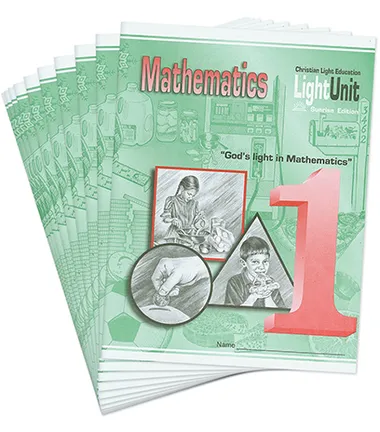
After trialing several math options for our 1st grader, including The Good and the Beautiful, Singapore Primary Mathematics, and A.C.E. paces, we settled on CLE.
“Ten LightUnits provides 170 lessons, including quizzes and tests. Each lesson introduces one or more bite-sized new concepts. Many of the student exercises consist of continuous review to ensure that concepts stick. Students experience math as a whole rather than as isolated skills.”
My Pros: If you have read my blog regarding the A.C.E. curriculum, you’ll know I really gravitate toward teaching early independence in self-learning for our children. The smaller workbooks with CLE are easily manageable, meaning they can be taken literally anywhere with ease (like in the car, to the park, a restaurant, etc.). Also, the fact that my children just individually feel amped when they complete so many individual booklets within a year to visually see how far they have come and how much they have left until the end of their school year is a big plus. This particular curriculum has 10 workbooks per grade level, which essentially means 1 month spent in each to complete a school year.
Unlike the A.C.E. Paces, the LightUnits are laid out in a simplified fashion. Not much, if any, reading text at all in the children’s workbooks as that’s all only listed in the Instructor’s Guide. There aren’t any comic strips or bible verses included in hopes of memorization. (My kids tended to skip over these exercises in the A.C.E. Paces simply because they didn’t find them engaging. We also already do our own separate scripture memorization and they don’t prefer the KJV text used as opposed to another translation, as it is, so that aspect was unnecessary for us.)
I personally like that the CLE LightUnits don’t put as many problems on each page vs. other curricula. My kids get VERY antsy after so many pages of the same review problems of simple +/-/x//. I, however, like the repetition and know how helpful it is to continue into later years of mathematics having quick recall from memory. For that reason, I especially appreciate the “Speed Drills” the LightUnits provide. It tricks my kids into thinking it’s not just review when you put a timer on it and they only have to complete what they can in 60 seconds. Haha!
The last of my pros is that, compared to the other math curriculum I’m familiar with, I’ve noticed CLE moves more quickly into more advanced math concepts. Most 1st-grade levels I’ve reviewed need to be skipped altogether by my smartie-pants 1st grader, as she is far beyond recalling and writing numerals (especially 1-10), skip counting by lower numbers, colors, shapes, etc. like what a lot of curriculums still focus on at the level. But this one, I really needed only to skip the very 1st LightUnit 101 because in the 102 it’s already teaching double digit addition or subtraction. That was a huge plus in ultimately deciding on this curriculum to use to begin with.
My Cons: This isn’t a con, per se, to some. However, it’s not really my teaching style to have to be present during any complete subject from the start of the lesson to the end of a lesson in our homeschool. I much prefer to introduce the topic and give them brief instructions but I usually have to be able to walk away when their individual work is getting done because I just have so many children (and dogs, and a husband, and household maintenance, and self-care, in general. AND that list goes on!) that pulls me in every direction all the time. That being said, I definitely see the importance of prioritizing the bulk of my attention to the youngest learners and since she is my youngest in age I do have a natural pull to be more present in her particular learning activities. The Instructor’s Guide is absolutely necessary for the use of the curriculum because, without it, you won’t know several of the worktext needed to be completed by the children. A lot of what they work out and write starts with you, as a teacher, verbalizing the word problems, etc. After seeing it with my own eyes and hearing that until the 3rd-grade level, it’s not able to be done very independently without much teacher interaction. So if you don’t have the time to spend math from start to finish with your learner, probably look elsewhere. By the time she’s in 3rd grade, however, it won’t require so much of my attention and I’m good with that timeline.
Overall, while we are still new to the use of it this first school year, I have high hopes of this being a great fit in our homeschool!